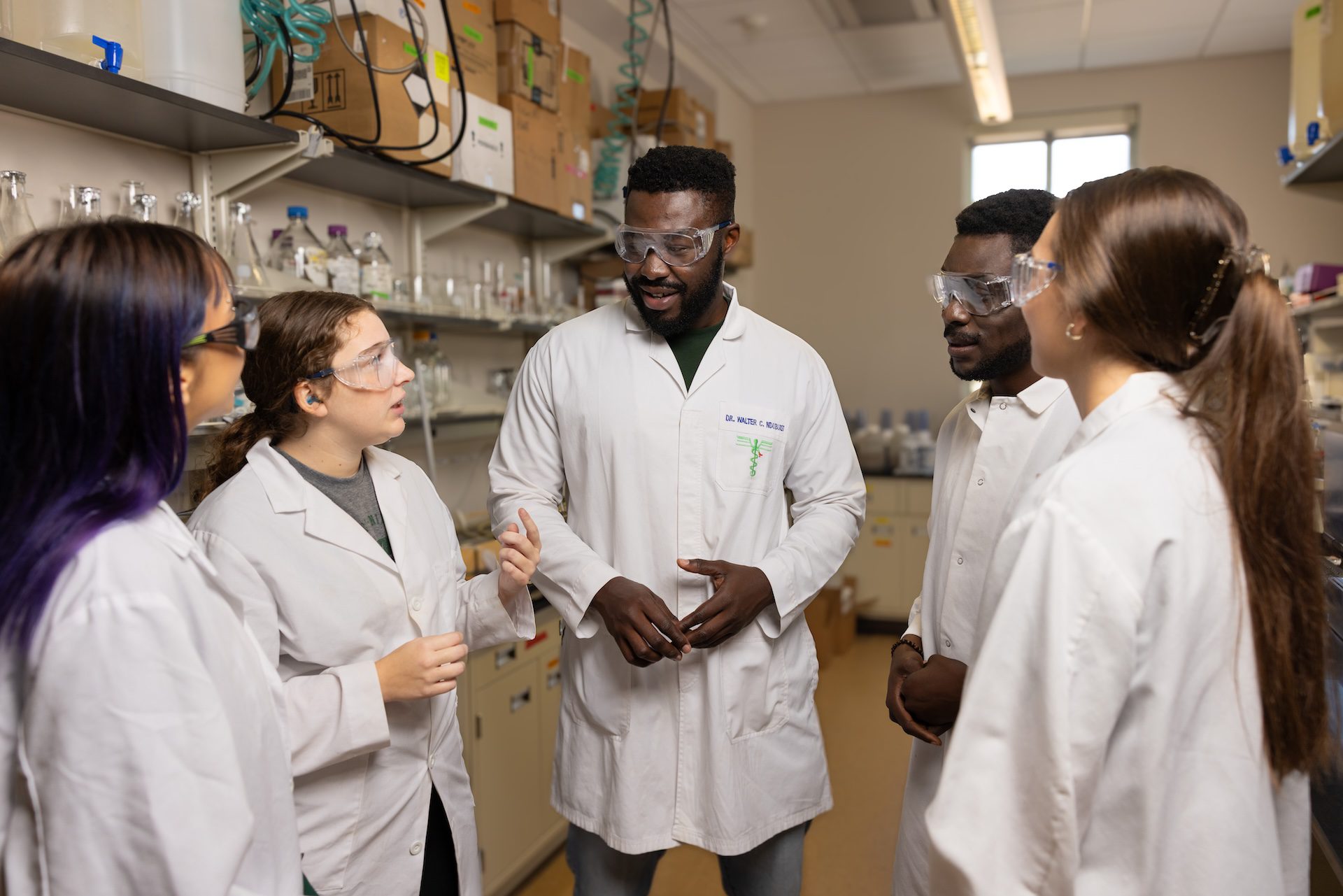A triple threat: A physician tackles global health through an environmental and public health lens

October 1, 2025
Chideraa Ndubuisi ’25 MPH is driven to improve human health. Through research — and an unquenchable appetite for learning everything he can about medicine, public health and environmental systems — he is exploring, analyzing and drawing conclusions about the levels of microplastics and halogenated organics, particularly brominated flame retardants, in municipal wastewater treatment processes.
To Ndubuisi, a physician trained in Nigeria, these emerging contaminants provide a perfect case study about factors that connect environmental, animal and human health. To gain clarity around these complex, multidisciplinary relationships — and make a difference for those who need help — he enrolled at UNC Charlotte. He’s halfway to his goal having completed a Master of Public Health in May, as his studies continue for a Ph.D. in infrastructure and environmental systems at the William States Lee College of Engineering.
A triple-threat expert, Ndubuisi is laser-focused on developing strategies locally that hold promise for broader impact. He knows that a firm understanding of how these microplastics and other pollutants are distributed within treatment processes will inform better comprehensive strategies that protect people and the environment on a global scale.
“Microplastics, flame retardants and other substances in wastewater are not new,” said Olya Keen, associate professor of civil and environmental engineering, “But our ability for detection is getting better, and our understanding of the extent of this pollution is coming into focus.”
Deciphering links between health and environment
Working with a large nearby wastewater utility, Ndubuisi collects samples from several treatment plants according to their service areas and associated activities. He is taking a close look at the levels of microplastics and BFRs based on their sources as part of his doctoral research for the W.S. Lee College of Engineering.
“The journey of these contaminants — from consumer and commercial use through treatment facilities then back to aquatic ecosystems or agricultural soils — illustrates the interconnected cycle of humans and our environment,” Ndubuisi explained.
Brominated flame retardants, chemicals applied to products to reduce flammability, and microplastics pose a synergic — and increasingly magnified — threat to human health. Some studies show isolated microplastics in the brains, cardiac tissues and other organs of humans, which can raise people’s risks for chronic inflammation, metabolic disorders, damage to the liver and kidneys, and reproductive and developmental harm.

“By investigating the fate and distribution of these contaminants throughout the wastewater treatment processes, I am addressing a critical link in the chain, with implications across the One Health spectrum,” said Ndubuisi, referring to the conceptual framework adopted by the World Health Organization that spans human, animal and environmental health, and emphasizes global health depends on the ability of all inhabitants and ecosystems working together.
Flame retardants are in wastewater treatment plants all across the country, Keen observed, but their presence globally will differ based on consumer products regulations. She points out that Ndubuisi’s research will lead to new knowledge on the cycling of these contaminants in wastewater treatment and better ways of managing the pervasive environmental pollution with microplastics and BFRs globally.
Using an interdisciplinary approach to problem solving
Ndubuisi recognizes his varied background qualifies him to make meaningful contributions in several disciplines.
“As a medical doctor, I understand the potential human health implications of these contaminants,” he said. “My training in epidemiology allows me to design studies that can identify patterns of exposure and potential health outcomes. And my environmental systems expertise helps me trace these substances through complex ecological pathways.”
Keen emphasizes the connection between environmental pollution and public health, and recent studies that prove the link between environmental pollutants and a number of diseases, which become more prevalent each year.
“This puts Chideraa in a great position to make a difference for public health,” she said.
Forging a path from Nigeria to Charlotte
The pursuit of excellence defined Ndubuisi’s childhood. Growing up in a middle-income home led by college professor parents, he learned success results from unwavering dedication and consistent hard work. Among his siblings are a lawyer, a pharmacist and an aspiring engineer completing a Ph.D. at the University of Missouri.

After finishing undergraduate studies and earning a medical degree from the University Maiduguri, located in his hometown, Ndubuisi completed a one-year internship at the University of Uyo Teaching Hospital. He then fulfilled mandatory National Youth Service Corps at Edwin Clark University where he managed community engagement initiatives with the Burutu Local Government Area.
These experiences led to interest in broader public health issues, specifically on how environmental health affects communities.
Charlotte became Ndubuisi’s top choice for continuing his education over Georgetown and George Washington University, which also admitted him. It was the opportunity to interact with Deborah Beete, director of the Master of Public Health Program, and Keen, who also is the graduate program director for civil and environmental engineering, that made the difference.
“Dr. Keen and I connected due to her kind and understanding nature and her own experience with international students. She provided assistance and encouragement throughout the long process,” said Ndubuisi. “Both she and Professor Beete introduced me to other international students in the two programs, and they were just so welcoming, accessible and responsive.”
Bridging the knowledge gap to promote public health
Now in his final three semesters at Charlotte, Ndubuisi continues to explore the concentration and distribution of microplastics and BFRs through the wastewater treatment training, which will be vital in developing implementable strategies for wastewater treatment plants to remove these pollutants.
“By identifying the pattern of distribution of these pollutants, I hope to provide evidence-based recommendations that treatment facilities can adopt without requiring complete system overhauls,” said Ndubuisi. “This could significantly reduce the environmental burden of these contaminants while we work on longer-term source reduction strategies.”
Looking to the future, Ndubuisi aims to become a leading expert at the intersection of environmental health and infectious disease surveillance. “My unique combination of medical training, completed epidemiological education and environmental systems expertise positions me perfectly for roles in public health agencies where I can apply my interdisciplinary perspective to complex health challenges.”
Returning to clinical practice is not off the table. With this option, he could focus on communities disproportionately affected by environmental contamination, and apply his specialized knowledge to better recognize, diagnose and treat conditions linked to environmental exposures.
“Regardless of the specific path I pursue, my goal is to serve as a bridge between environmental science and public health practice,” said Ndubuisi. “I want to translate complex research findings into practical applications that protect community health, whether through improved wastewater monitoring systems, more effective disease surveillance or more informed clinical care.”